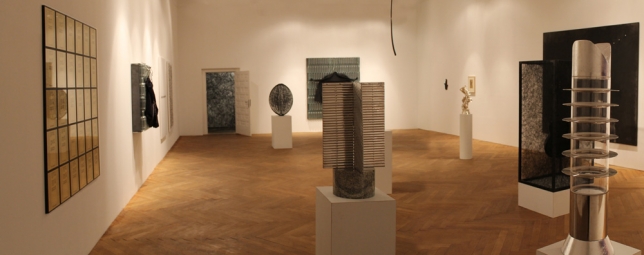05.11.2011 - 29.02.2012
THE EPHEMERAL
Exhibition website
Group show with works by:
Absalon | Moridja Kitenge Banza | Joseph Beuys | Hanne Darboven | Wim Delvoye | Rebecca Horn | Mathilde ter Heijne | Jannis Kounellis | Keisuke Matsuura | Christian Megert | Heinz Mack | David Noonan | Henk Peeters | Otto Piene | Jackson Pollock | Julian Rosefeldt | Matt Saunders | Chiharu Shiota | Miroslav Tichý | Grazia Toderi | Susan Turcot | Franz West | Nick van Woert | Yang Jiechang
The Ephemeral is an exhibition of 26 artists all dealing with elements and traces of the morbid, the delicate, and the temporary. They convey that small gestures can have a big impact and that especially the “silent scream” can be heard crystal clear once you fade out the ambient noise (das Grundrauschen) that surrounds us everywhere today.
Artists have always analyzed questions of the ephemeral in their work. In doing so, many artists have not merely used materials and means of expression that might disintegrate or which border on the immaterial, but rather have foregrounded the very changeability of the artwork itself.
Thus, for instance, the works of Jannis Kounellis contrast substantial materials such as coal and metal with mutable or intangible materials such as frost covering slabs or fire burning in lamps fuelled by a limited supply of petroleum.
Often enough, the ephemeral appears to be a fragile apparition wavering on the edge of existence, such as in a drawing by Joseph Beuys; the ephemeral draws its power precisely from its evanescence. But the ephemeral can also function as a warning highlighting the transience of all being. Such memento mori, remind the viewer of death and the finitude of the self. In a pietà by Beuys, the memento mori is twisted into a promise that death might not be the final station after all. The art of Miroslav Tichý seeks to apprehend the brevity of the moment by dwelling on a young girl bathing, suffused with the full romantic melancholy of one who is aware that beauty fades.
Some creative acts appear brief only when measured solely by temporal criteria. The flash of insight and inspiration is followed by what can be a protracted, laborious process, yet the final product nevertheless preserves the freshness and revelation of the distilled thought. The artwork transforms the thought into a form that allows the moment to be recreated, without allowing it, in its eternal repetition, to grow insipid. Movement too belongs to the fleeting manifestations of art, such as the elegant, occasionally jerky but nevertheless graceful motions of Rebecca Horn’s machines, or a historical moment captured on video. Julian Rosefeldt and Piero Steinle have gathered historical photographs of explosions of equally historic buildings to a pandemonium of iconoclasm. The time of the explosion becomes a point in time demonstrating both the finite nature of the moment as well as the powerful effects beyond the destruction. Even destroyed these moment keep their meaning. In these moments proves to be the special aura of the art, which is in the best position to act between the precarious and the constantly incomprehensible.
Grazia Toderi’s films have that ethereal and almost spiritual ambiance, impossible to localise in the past, present or future.
Heinz Mack had such an optimistic and constructive approach towards the future already in the works of his Zero phase in the 1960s: In his attempt to capture the traces and essence of light in his sculptures that look rather similar to scientific installations than to at that time traditional artworks, his work even 50 years later still looks like coming directly back from the future to pay us a visit.
The exhibition will be accompanied by its own webpage. Please visit www.theephemeral.com, contact us for further information at info@arndtberlin.com or download the online catalogue.

